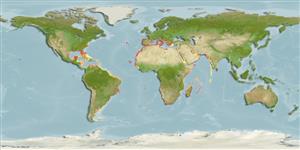Preferred temperature (Ref.
123201): 18 - 27.9, mean 26.4 °C (based on 1539 cells).
Phylogenetic diversity index (Ref.
82804): PD
50 = 0.5000 [Uniqueness, from 0.5 = low to 2.0 = high].
Bayesian length-weight: a=0.01096 (0.00465 - 0.02585), b=2.99 (2.81 - 3.17), in cm total length, based on LWR estimates for this Genus-body shape (Ref.
93245).
Nível Trófico (Ref.
69278): 3.2 ±0.40 se; based on food items.
Resiliência (Ref.
120179): Elevada, tempo mínimo de duplicação da população menor que 15 meses (Preliminary K or Fecundity.).
Fishing Vulnerability (Ref.
59153): Low vulnerability (10 of 100).
🛈
Nutrients (Ref.
124155): Calcium = 185 [102, 374] mg/100g; Iron = 1.38 [0.88, 2.36] mg/100g; Protein = 18.8 [17.9, 19.6] %; Omega3 = 0.373 [0.230, 0.607] g/100g; Selenium = 15.1 [8.2, 30.1] μg/100g; VitaminA = 23.9 [8.3, 66.4] μg/100g; Zinc = 1.19 [0.85, 1.71] mg/100g (wet weight);
